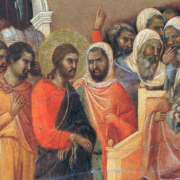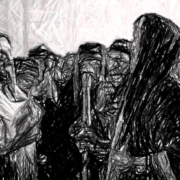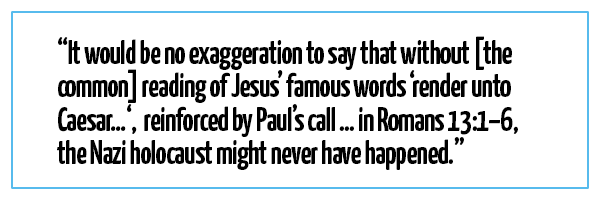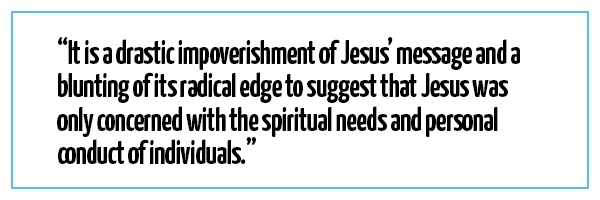Anabaptist Ethics and Same-Sex Marriage (Part 2)
Bruce Hamill | Monday, 13th July 2015
In the first half of this article, Bruce discussed that New Testament ethics is apocalyptic in nature, characterised by the newness of creation established by the life, death and resurrection of Jesus. Here he moves to apply this approach to ethics to the topic of marriage.
MARRIAGE IN AN APOCALYPTIC PERSPECTIVE
How then might an apocalyptic and Anabaptist Christian ethic affect our thinking about marriage?
My case for a rethinking of the definition of marriage to permit same-sex marriage comes under four headings: (1) institutional reform, (2) the normativity of eschatology for Christian ethics, (3) embodied salvation: the relevance of biology and psychology, and (4) the role of marriage in sanctification.
The “good newness” of the apocalypse that is the Messiah Jesus had a significant destabilising impact on the social world of Jesus own time. It is a theme of the gospels that Jesus is constantly in conflict with the moral authorities of his Jewish world and ultimately with the Roman world as well. At the heart of this moral revolution lie two ethical moves embedded in both his practice and his teaching: i) his extension of neighbour-love to include enemy-love, epitomised in the parable of the Good Samaritan, and ii) his ethic of non-violent resistance — “You have heard it said ‘an eye for an eye…’ but I say to you do not (violently) resist the evil doer”. In both cases Jesus is confronting ethical and religious orthodoxy head on. The long-term impact of this moral revolution is difficult to overstate.
For the purpose of this argument, what is important to notice, is that this new ‘way’ leads and cannot help but lead to serious institutional reform for those apocalyptic Jews for whom Jesus was Messiah.
1. Institutional Reform
We have noted Jesus’ critical engagement with that most sacred of institutions — Torah. The creative use of Torah in service of the gospel became a feature of New Testament writings. Similarly other institutions did not come off unscathed in their encounters with Jesus of Nazareth. Jesus’ willingness to run-roughshod over purity codes is well known. This in turn was taken up in Peter’s vision in Acts leading to a radical revision of the way ethnic identity was related to the institution of the ‘people of God’. In forming his small community of disciples, Jesus’ approach to the institution of the family could be regarded as subversive. Perhaps most obviously Jesus was an intrepid reformer of the Sabbath and its associated practices.
The question thus arises whether Jesus’ motto ‘the Sabbath was made for man, not man for the Sabbath’ (Mk 2:27) might well apply to marriage.
It is consistent with all of this that the protest wing of the Catholic Church, which calls itself the Reformed tradition, understands itself to be committed to the constant reform of the institutions within which disciples of Jesus seek to live their lives — ecclesia reformata semper reformanda [“the reformed church (is) always to be reformed”]. For them it is first of all a refusal to make idols of our institutions. This is certainly not a license for arbitrary social novelty. But the institutions within which the people of God live their lives are not platonic forms; they are not eternal and immutable simply by virtue of an idea or definition. There is constant pressure from the Triune God for their reform. The working out of the gospel means that the church is always learning how to be the church in ordered and structured ways.
Should we exempt marriage from such reforming processes? It seems to me that the onus is clearly on the traditionalists to come up with a reason.
However before moving too quickly we need to note that the rejection of a platonic view of the institution of marriage is not the same as the abandonment of all definition. We still need to address the question of when a marriage is not a marriage. To put it another way: we need to distinguish between reform and merely changing the subject. To reform an institution is not to reject it but to affirm some purpose for which that institution exists, even if that purpose is itself being rethought in the light of something new.
If, for example, the primary purpose of marriage were procreation there would hardly be a case for reforming marriage to allow same-sex marriage. However as many have observed,[1] in the second creation narrative in Genesis 2 procreation is secondary to a more primary purpose, namely companionship (Gen 2:18–25) and indeed the latter is the explicit reason given for the creation of a complementary partner for ‘adam’. It is this purpose which is developed and redefined in the New Testament in terms of communion, especially the eschatological communion of which the ecclesia, the community of the Messiah, is a foretaste.[2]
2. The Priority of Eschatology
If the institutional reform which so characterised the advent of the new aeon is the outer frame and mandate for an ongoing process of organising all of life under Christ, then the inner frame which guides the logic of Christian ethics is Jesus Christ and his mission.
Here we return to the methodological implications of apocalyptic theology for ethics. Since the ‘good newness’ of this apocalypse is not an evolution of something already immanent within the old aeon, or a logical progression from its premises, it follows that life in Christ, in the ‘time between the times’ cannot be defined by anything other than Christ. The old aeon is the context to which Christ comes but it cannot provide the norm for life in the new aeon. Ethically speaking, this is indeed ‘the year of our Lord’, a time in which eschatology (apocalypsed in Jesus Christ) has a certain logical priority for Christian ethics. The defining moment for history becomes also the defining moment for Christian ethics (its norm).
Thus in Christian ethics, nature and the structures of creation play a subordinate role to the ‘new creation’ in Christ. This is a complex claim, and though it seems a clear outcome of Paul’s gospel it is expressed in mixed and ambiguous ways in his ethics.[3] Eugene Rogers argues that that at least two things are clear for Paul: God can and does, on occasions, work counter to ‘nature’,[4] and, secondly, since grace transforms nature, nature is not normative.
Jeffrey Stout summarises Rogers’ argument well:
Natural Law is an important Christian idea… but an ethic of natural law always runs the risk of treating untransformed nature as normative for Christians whereas the whole point of the body of Christ is to transform the natural. The Christian norm for sexuality is not natural law, it is rather human nature transformed, eros swept up into agape.[5]
This latter point finds its clearest expression in Galatians 3:28 when Paul claims not only that oppositional pairs Jew/Gentile and slave/free (with their correlative institutions, nationhood and slavery) are not determinative of life ‘in Christ’, but also that the complementarity of male/female is similarly subordinated to life ‘in Christ’. His switch of conjunctions from ‘or’ (Jew nor Gentile, slave nor free) to ‘and’ (male and female) is a clear reference to the Genesis narrative (‘male and female created he them’ Gen 1:27). This is worth pausing with. Paul is not merely claiming that, for the purposes of Christianity, it doesn’t matter whether you are male or female. His claim is much broader. The ‘male and female’ structure of creation no longer matters. Clearly Paul is not claiming that either slavery, ethnicity or marriage no longer exist for the people of God, but rather that they are all relativised in the light of their ‘end’ (eschatologically). The great complementarity of ‘male and female’ may still exist, but it does not normatively define life in Christ. Jesus Christ, the one ‘in whom and for whom’ (Col 1:16) we are created provides not merely momentum for change, but a new norm towards which all our practices and institutions ought to be redirected. His form of life defines the forms of life in which we live. The good life is an embodiment of his future made possible now.
Paul understands marriage in precisely this context when, in Eph 5:31–32, he sees the marriage relationship as a sign referring to Christ’s relationship to the church — “’and the two will become one flesh’. This is a profound mystery — but I am talking about Christ and the church.” It is the way in which Paul, on the one hand, talks about marriage in male/female terms (Eph 5:32) as a sign, or perhaps icon, of the mystery of the love of Christ, and on the other hand declares those same male/female terms to be non-determinative of our life in Christ (Gal 3:28) that leads Rogers to argue that other terms and relationships could bear witness to the same reality (Christ’s relation to the church).
What Rogers and Rowan Williams[6] before him are arguing is that the point of marriage, as the church is learning to practice it in the light of the eschaton, lies in our human expression of the divine love, the love of Christ for the church. In becoming ‘one flesh’ we learn in the most bodily way possible what it means to share the love of Christ and thus be his body as we give our bodies to one another, imaging the one who gave his body for us. I will say more on this in a moment.
3. Embodied Salvation: The Relevance of Biology and Psychology
The apocalyptic context and eschatological norm in no way suggests that the Christian life is somehow divorced from the ‘old creation’ or from biology and history after the manner of gnostic ontology. It is for the reorientation and reconstruction of this creation that Christ comes. In seeking to take seriously the biological and psychological context in which marriage is practised, we will rely on relevant scientific disciplines. In the ancient world of the biblical writers there was little understanding that the dynamic processes of human desire might be constrained and structured according to a same-sex orientation as well as a heterosexual one. Inasmuch as science has deepened our understanding of these matters it provides a significant mandate for reconsidering the modes of marital expression that the kingdom of God might take among the people of God.
When Paul in Romans 1 (assuming it is Paul and not the words of a protagonist as Douglas Campbell argues[7]) considers same-sex desire and practices as impure he does not consider them in the context of a Christian couple seeking to discipline their sexual orientation in practices of love. In stark contrast he is thinking about same-sex desire and practice in the context of idolatry and the pagan temple. However, what is most difficult about Romans 1 is that rather than appeal to the gospel of the new creation he reverts to the language of nature and purity in his comments regarding same-sex relations. This and his judgements about men with long hair stand out as exceptions to his normal approach to Christian life and ethics (1 Cor 11:14-15).
In the final section we will do what Paul does not do in Romans 1, namely consider the possibility of same-sex marriage as a practice within the context of the Christian life.
4. Marriage as Sanctification
According to Rogers the biological and psychological context of the Christian life is such that, for some of us, there are some partners who are “apposite without being opposite”. Assuming then that this kind of institutional extension for the sake of such biologically apposite partnerships were possible, does it matter whether the church marries them or not? What matters here, says Rogers, is sanctification (rather than say mere satisfaction). Indeed, what matters are communities of sanctification which are structured as institutions of discipleship. Rogers talks of marriage as a sacrament, rather than an institution of discipleship, as I do, though I think the differences fade provided one’s account of discipleship is communal and participatory. For Rogers the sacramental marriage is a community within the community of the body of Christ, which in turn exists within the communal Trinitarian life of God[8].
Indeed the same passage in Ephesians where Paul talks of the one-fleshness of marriage as a kind of icon of the love of Christ — a living symbol of God’s salvation — he also talks of it in terms of neighbour-love intrinsic to the body of Christ. “He who loves his wife loves himself, for no man ever hates his own flesh…” (Eph 5:28–29). This two-fold aspect of marriage — both as symbolic witness and as formative discipleship — is expressed the 2010 report of the bishops of the Episcopal Church:
Marriage bears witness to both of the great commandments: it signifies the love of God and it teaches the love of neighbour.[9]
This latter aspect treats marriage as the ascetic discipline of learning to love our nearest neighbour as our self. This point is important because, as Rogers stresses,[10] bodies matter in salvation. Because we are being saved as embodied creatures in all the particularity of our limitation, then we should seriously consider revising the limits of our doctrine of marriage.
Rogers describes same-sex marriage as a species of complementarity — not the ‘rigid complementarity’[11] defined by procreative biological pragmatism alone — but ‘Christologically disciplined complementarity’ defined by the process of learning in all the particularity of one’s bodiliness both ‘the love of God and God’s people’.[12]
CONCLUSION
Let me summarise the argument as a whole. Marriage — that ancient institution serving the nurture of companionship and human flourishing in love — has for most of Christian history been assumed to be defined by the biological complementarity of ‘male and female’, although not necessarily by procreation. In Jesus and the apocalyptic Christian writers not only does the coming kingdom relativise the institution of marriage to this ‘time between the times’, it sets it, and all the other institutions within which we live, under the authority and judgement of Christ. In doing this it re-establishes marriage in terms of a new purpose for disciples of Christ — indeed a two-fold purpose — to bear witness to the new creation seen in the love of Christ for the church and to practise the life of that new creation in intimate acts of mutual and bodily self-donation. This ethical revolution reaches its clearest expression when Paul concludes that even creational structures like ‘male and female’ do not define life in Christ. It is thus a small step with the benefit of biological and psychological science to conclude that other creational structures such as same-sex orientation might, for some, provide a more appropriate vehicle for the discipline of marriage.
God, grant us the serenity
To accept the things we cannot change
The courage to change the things we can
and the wisdom to know that we probably don’t know the difference
And that you, our God, are, nevertheless, not limited by our incapacity.
— Modified ‘Serenity Prayer’
[1] Christian Perspectives on Marriage: A Discussion Document (PCANZ: May 2014), edited by the Doctrine Core Group of the Presbyterian Church of Aotearoa New Zealand. In this document two of the anonymous contributors make this point. c.f. contribution 2, especially p. 11, and contribution 7.
[2] Procreation certainly features in the first creation narrative in association with the creation of male and female, however as the scriptural narrative progresses it plays a minor role, especially in the New Testament. Arguably the task of ‘filling the earth’ as a species’ responsibility is a completed one.
[3] In this respect I am thinking particularly of the role of nature in Romans 1:26-7 on ‘unnatural’ intercourse and 1 Corinthians 11:14-15 on ‘unnatural’ hairstyles for men.
[4] Later in Romans Paul characteris
es the process of grafting Gentiles into Israel as an ‘unnatural’ act of God (Romans 11:21–24).
[5] Jeffrey Stout, “How Christianity Transcends the Culture Wars: Eugene Rogers and Others on Same-Sex Marriage,” Journal of Religious Ethics 31/2 (2003): 175.
[6] Rowan Williams, “The Body’s Grace”, in Theology and Sexuality (ed. Eugene Rogers; Malden: Blackwell: 2002), pp. 309–321.
[7] Douglas A. Campbell, The Deliverance of God: An Apocalyptic Rereading of Justification in Paul (Grand Rapids: Eerdmans, 2009), 313–593.
[8] Stout, “How Christianity transcends the culture wars” p. 175
[9] I refer to the 95 page ‘Theology of Same-Sex Relationship’ published in the Anglican Theological Review (Winter, 2011) and cited by Eugene F. Rogers Jr in “Same-Sex Complementarity: A Theology of Marriage” in The Christian Century (May, 2011).
[10] Rogers, “Same-Sex Complimentarity.”
[11] Rogers, “Same-Sex Complimentarity.”
[12] Rogers, “Same-Sex Complimentarity,” writes, “Christ trains — or orients — all desire to God. Saying there is ‘no “male and female”’ denies, therefore, strong forms of the complementarity theory, according to which a woman remains incomplete without a man or a man incomplete without a woman. Taking that theory to its logical conclusion, effectively denies the Christ in whom all things are “summed up” (Eph 1:10)”
Rev Dr Bruce Hamill is the Minister at Coastal Unity Parish, a Presbyterian Church in Dunedin, New Zealand. He has a PhD in Systematic Theology from the University of Otago.





 There is no time to exegete either of these two passages in detail here.
There is no time to exegete either of these two passages in detail here. To sum up thus far: Once we cast off the modern blinkers we bring to the gospel story, it becomes clear that Jesus’ message of the dawning kingdom of God had significant political implications. His announcement that God’s long awaited reign was now asserting itself in the world, and his consequent summons for people to rally to the flag, had, as Wright observes “far more in common with the founding of a revolutionary party than with what we now think of as either ‘evangelism’ or ‘ethical teaching’”.
To sum up thus far: Once we cast off the modern blinkers we bring to the gospel story, it becomes clear that Jesus’ message of the dawning kingdom of God had significant political implications. His announcement that God’s long awaited reign was now asserting itself in the world, and his consequent summons for people to rally to the flag, had, as Wright observes “far more in common with the founding of a revolutionary party than with what we now think of as either ‘evangelism’ or ‘ethical teaching’”.
 Thankfully the church no longer burns witches or deploys its own armies. But most confessing Christians, and a disappointing number of our pastors, bishops and theological educators, not to mention our politicians, are still disturbingly deaf to the political dimensions of Jesus’ preaching and practice, and to its far-reaching implications for shaping an authentically Christian political witness today. But why is this the case? Why do modern readers of the gospels still commonly, if not completely, miss the political ramifications of Jesus’ proclamation? And why is it that today’s Christian voice in the public square is so often bereft of any anchoring in the story of Jesus, whether explicit or implicit, thus allowing alternative sources of authority, such as conservative middle class values and morality, to fill the vacuum? Whence comes this depoliticised Jesus?
Thankfully the church no longer burns witches or deploys its own armies. But most confessing Christians, and a disappointing number of our pastors, bishops and theological educators, not to mention our politicians, are still disturbingly deaf to the political dimensions of Jesus’ preaching and practice, and to its far-reaching implications for shaping an authentically Christian political witness today. But why is this the case? Why do modern readers of the gospels still commonly, if not completely, miss the political ramifications of Jesus’ proclamation? And why is it that today’s Christian voice in the public square is so often bereft of any anchoring in the story of Jesus, whether explicit or implicit, thus allowing alternative sources of authority, such as conservative middle class values and morality, to fill the vacuum? Whence comes this depoliticised Jesus?